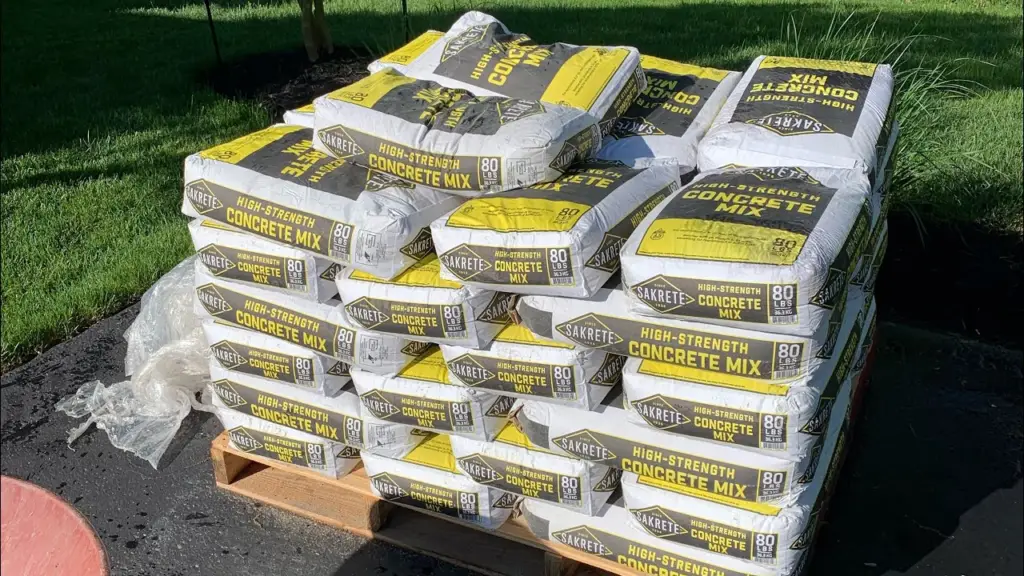When concrete comes in volume, it normally comes on a pallet. This makes the whole process much easier to transport with a fork lift.
Concrete manufactures package their product differently based on the mix and the weight. Typically, concrete comes bagged in weights of 40, 50 and 80 pounds.
However, standard concrete is offered in every weight and some mixes are only offered in lighter weights.
When you are at a store like home depot, you must have noticed that the concrete pallets are sometimes wrapped in plastic with a number written on them in marker.
That is the number of bags on the pallet. Sometimes store man will order an odd number from another pallet onto a fresh one and this can create odd numbers.
It is very important to know the correct type of concrete as well as the quantity of bags.

Table of Contents
- 1. How many bags of concrete are on a pallet?
- 2. How many bags of concrete are required?
- 3. How much does a pallet of concrete weight?
- 4. How many yards of concrete are on a pallet?
1. How many bags of concrete are on a pallet?
You might have seen different sizes of concrete bags for various reasons, however mostly it is to offer diversity to customers in terms of tailoring the appropriate amount of concrete they might want. There are some of the commonly used bags of Quikrete concrete mix are as follows:
1. 40 Pounds Concrete Bag
On average there are 80 bags of 40 lb. concrete mix on a pallet. So, the total weight of this pallet is around 3200 lbs. Most pallets weight in at or just above this total weight. Therefore, if you have another type of concrete in a bag and wonder how many bags it will take to make up a pallet then you can use 3200 lbs. as a general estimate.
2. 50 Pounds Concrete Bag
On average there are 64 bags of 50 lb. concrete mix on a pallet. Generally, this weight is not available for many types of concrete mix, as the bag weight tend to rise evenly. Often exclusively, different types of mortar mix do come in 50 lb. bags.
Also Read: How Many bags of concrete Needed per Fence Post?
3. 60 Pounds Concrete Bag
A pallet of 60 lb. bag concrete contains roughly 56 bags of Quikrete concrete mix. Which also means that 60 pounds are just under 30 kilograms.
4. 80 Pounds Concrete Bag
The 80 pounds of concrete is the standard bag size and a pallet of 80 pounds concrete bag will contain 42 bags which makes it the largest size of bags available for most concrete mix types.
Also Read: M25 Mix Concrete Ratio (1:1:2) – Uses – Materials
5. 90 Pounds Concrete Bag
You might have noticed that when the pounds percentage of any concrete bag increase, it decreases the number of bags. Therefore, a pallet containing 90 pounds bag of concrete mix will contain 35 bags. Normally most concrete mixes don’t offer 90 pounds as they only offer numbers divisible by 20. However, many different cement and masonry mixes do over 90 lb. bags and more.
| Bag Weight | Numbers of Bags |
| 40 lb. | 80 Bags |
| 50 lb. | 64 Bags |
| 60 lb. | 56 Bags |
| 80 lb. | 42 Bags |
| 90 lb. | 35 Bags |
2. How many bags of concrete are required?
Determining the actual numbers of concrete mix bag can be tricky, even though the package itself indicates how many cubic feet each bag will cover. On average, an 80 lb. bag of concrete typically covers 45 cubic feet, while a 60 lb. bag of concrete mix will cover around 30 cubic feet.
Be sure to buy one or two extra bags just in case. Suppose you build a 15×10 concrete patio at 4-inch-deep, then you are going to need 80 bags of 80 pounds. Which also means that roughly two pallets of concrete for just 4-inch patio project.
Also Read: Harsh mix of concrete – Harshness in Concrete is due to
3. How much does a pallet of concrete weight?
Normally one a pallet of 80 pounds of concrete mix bag contains an average weight of 3200 pounds. It is difficult to get each pallet of various concrete mixes to weight the same as the sizes of concrete bags vary. For example, a pallet of 40 lb. bags weights around 3200 lbs. which is slightly less then the 80 lbs. bag.
In general practice, a pallet is not supposed to exceed the height of 7 feet which ultimately reduces the numbers of bags on a pallet. Same goes for 60 lbs. of concrete mix bag which weights around 3360 pounds same as the 80 lbs. pallet. This is because the physical size of the bag is smaller than an 80 lbs. bag making it easy to fit more bags on a pallet before it reaches the height constraint.
Also Read: How much does a bag of concrete cover? (Bags of 40 lb, 60 lb, 80 lb, & 90lb)
4. How many yards of concrete are on a pallet?
Under normal circumstances, a pallet of concrete makes just one cubic yards of concrete. For better understanding, take an example of one 80 lbs. bag of concrete covers 0.6 cubic feet. Multiplying 0.6 by 42 bags, you can easily figure out that you a pallet that covers just over 25 cubic feet.
As we know that there are 27 cubic feet in one cubic yard, therefore a pallet of concrete covers just below one cubic yard. This coverage amount is more or less same for 60 lbs. bag of concrete mix. However, a 40 pounds bag of concrete has 80 bags on a pallet and each bag will make around 0.3 cubic feet.
Also Read: How much is a yard of concrete? – With Bonus tips to save money
Multiplying 0.3 by 80 bags you will know that an entire pallet of 40 lbs. will make 24 cubic feet of concrete. Which when converted into cubic yards covers 0.88 cubic yards. In a nut shell, the pallets of smaller bags of concrete mix make slightly less than the pallets of the big boys by about one cubic foot on average.
Use our Calculators:
- How far can you span with flitch beam? (Design with online calculator)
- LVL Beam – Everything including Sizes – Cost – Span Calculator
- Concrete Block Calculator – How many blocks you need?
- Weight of concrete per cubic foot – With Examples – (Including Calculator)
- How much is an acre in square feet – Acre to sq ft (With Calculator)
So, once you know the quantity of concrete mix bags on a pallet, you can start thinking of buying and having them delivered to your backyard to carry out your desired activity.
Further Read: How much is a yard of concrete? – With Bonus tips to save money

















